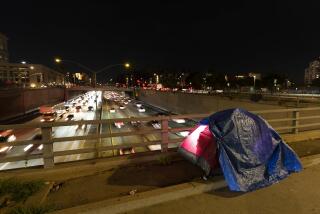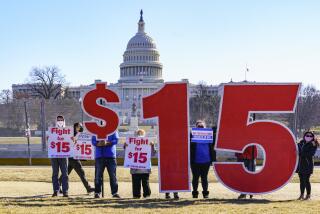Poverty Rate Falls to 11.3%, but Trouble Looms
WASHINGTON — The percentage of Americans living in poverty fell to 11.3% last year as the benefits of a growing economy brought new wealth to most U.S. regions and historically disadvantaged population groups, the Census Bureau reported Tuesday.
In glowing testimony to an economic expansion that may now be over, poverty declined by broad measures across racial groups and household types. Overall, the number of Americans living in poverty fell by 1.1 million, to 31.1 million. For a family of four, the poverty line in 2000 was $17,603; for a family of three it was $13,738.
The data pointed to some cooling in household income, with certain groups and regions experiencing modest declines. Median household income, the level at which half of households earn more and half of households earn less, was $42,148, just below record highs.
But analysts cautioned that the upbeat figures may reflect a golden era that has abruptly ended, given the many woes that now beset the U.S. economy. The census figures are based on a March survey in which 50,000 households were asked questions about last year.
Today’s rising unemployment, declining consumer confidence and economic turmoil sparked by the terrorist attacks suggest that short-term reductions in the poverty rate may prove hard to come by in the near future, experts said.
“While 2000 was a banner year for reducing poverty, it’s likely to be the high-water mark for a while,” cautioned Robert Greenstein, executive director of the Center on Budget and Policy Priorities, a liberal public policy center that closely studies poverty issues. “Forecasters believe we’re in a recession, and poverty always rises in recessions.”
The record low of 11.1% was set in 1973, but census officials Tuesday said the new figure of 11.3%--half a percentage point below the 1999 rate--was statistically little different.
The census report provided evidence that much of the country, including many of its least affluent residents, continued to experience economic gains as recently as last year. In 2000, the poverty rate declined for the fourth consecutive year.
Despite gains at the bottom, however, the economy was characterized by sharp disparities, according to the report:
* The 22.1% poverty rate for blacks was almost double the national level, yet it also represented an all-time low for that group. The 22.2% level for Latinos also matched the group’s low. Female-headed households also experienced a much-higher-than-average poverty rate of 24.7%, yet that percentage rate also represented a new low.
* Poverty rates varied widely. The 10.8% figure for Asians and Pacific Islanders matched the group’s record low. The 7.5% figure for non-Latino whites also matched the previous low.
* Poverty levels declined in California, New York, Arizona, Florida, Minnesota, Mississippi, New Hampshire, North Dakota, Oregon, Pennsylvania and the District of Columbia. New Mexico, Louisiana and the District of Columbia had the highest rates of poverty.
* Men with full-time year-round jobs experienced a 1% drop in median earnings to $37,339, the first such decline in four years. There was no such decline for women in similar positions, although their median income--$27,355--was lower than the men’s.
The Northeast was the only region where median household income rose faster than inflation. Yet overall, the median household income of $42,148 slipped just below the record of $42,187 in 1999--a performance that census analysts said was extremely strong.
“There are other ways people consider themselves well off or not. But . . . if you use these measures, people are as well off as they have ever been,” said Daniel Weinberg, chief of the Census Bureau’s division of housing and household economics statistics.
The pattern of income gains also was apparent among minority groups that often measure below average in wealth. Median household income for Latino families climbed to a high of $33,447; for blacks it also set a record of $30,439. Income measures for whites and Asians matched the previous peak levels of those groups--$45,904 for non-Latino whites and $55,521 for Asians and Pacific Islanders.
More to Read
Get the L.A. Times Politics newsletter
Deeply reported insights into legislation, politics and policy from Sacramento, Washington and beyond. In your inbox three times per week.
You may occasionally receive promotional content from the Los Angeles Times.










